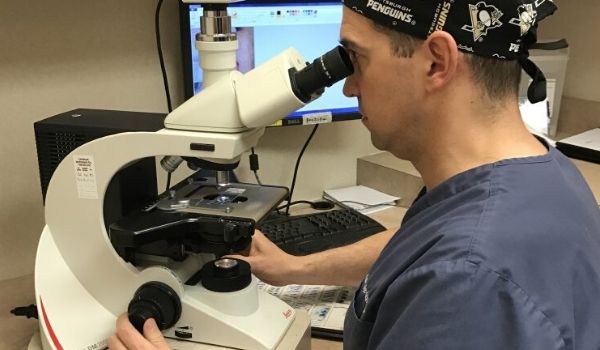A common surgical dermatology procedure used to treat skin cancer is Mohs Surgery. However, for a lot of patients, this may be a new term. So, what is Mohs Surgery? Let’s dive into this procedure further.
What is Mohs Surgery?
Mohs Surgery is the most advanced and accurate form of treatment for skin cancer. Skin cancer is a common reason to seek treatment from a dermatologist. One in five Americans will develop skin cancer at some point in their lives.
With so many people affected by skin cancer, early detection is crucial. Early detection of skin cancer, through an at-home or in-office skin cancer screening, can increase your chances of curing your skin cancer. An at-home head-to-toe skin cancer screening should be conducted each month. An in-office screening with your dermatologist should be scheduled when you notice any abnormal or itchy growths or moles that have changed since your last at-home check.
If an area has been identified as possible skin cancer your dermatologist will perform a biopsy of the area. The biopsy will confirm whether the area of concern is skin cancer. Once skin cancer is confirmed, treatment options will be discussed. Mohs Surgery is the most common and effective treatment for skin cancer. So, let’s dig a little deeper into what this procedure is and why it may be the right choice to treat your skin cancer.
Background on Mohs Surgery
The Mohs procedure was first developed in the 1930s. Over the years, Mohs Surgery has become the most precise treatment for a variety of skin cancers. It has the highest level of effectiveness for a cure, even if other methods have already been used. What makes this procedure unique is that only skin with cancer cells is removed. This is especially important when areas with only a few tissues layers are affected, such as eyelids, ears, and your hands.
What to Expect for the Procedure
The Mohs procedure is a micrographic surgery that involves removing the cancer cells, microscopically examining the cancer cells, and then reconstructing the affected area. During the procedure you are awake and alert, so there is no need to be hospitalized for this procedure. The entire procedure is completed in one session at our Mohs Surgery Center.
During the procedure, one layer of skin is removed at a time and is examined within the on-site laboratory. During this examination, the affected area is temporarily bandaged. This process of tissue removal and examination is repeated until all the cancer has been removed. Once all cancer has been removed, the affected area will be reconstructed and bandaged.
Following the procedure, you will be given a detailed list of after-care instructions, which your dermatologist will review with you. This information will include when and how to change your bandages, information regarding any medications you have been prescribed, and when you can return to normal activities. Your dermatologist will also go over how to care for your scar and ways to diminish your scar quickly.
Our Mohs Surgeons
Our surgeons are highly trained and are members of the American College of Mohs Surgery. Members of this organization are required to complete a one-year fellowship that is fully dedicated to the hands-on learning of the Mohs procedure following their residency training.
Not only is our office equipped with highly trained dermatological surgeons, but all Mohs procedures take place in a state of the art Ambulatory Surgical Center. This center houses two innovative surgical operating rooms, as well as procedure rooms, monitored recovery rooms, and a CLIA-certified laboratory. The entire Mohs Surgery takes place within this center, creating an efficient and convenient experience for you.
If you would like to learn more about Mohs Surgery as a treatment option, contact us today. Vujevich Dermatology Associates offers medical, surgical, and cosmetic dermatology from some of the most highly trained physicians and clinicians in the greater Pittsburgh area. You can reach our team at 412-429-2570 or visit our contact page to see all of our locations. You can also follow us on Facebook to see what’s new in the world of dermatology.

